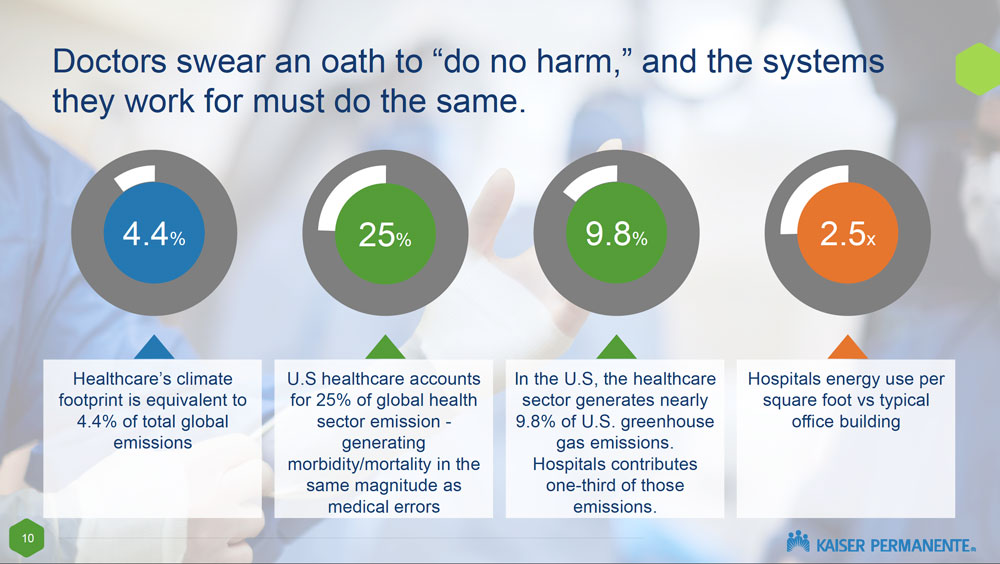Kaiser Permanente Northern California Regional President talks environmental sustainability in health care
Owen Plietz, MHA '00 speaks with Health Administration students
Do No Harm.
Like the promise doctors make to their patients, health care systems must do the same for their communities when it comes to environmental sustainability.
That was the message delivered to VCU Health Administration students by Carrie Owen Plietz, FACHE, a 2000 MHA graduate who serves as the Kaiser Permanente Northern California Regional President.
“We need to expand this concept of ‘Zero Harm’ from patient care to our community,” said Owen Plietz, the Paul A. Gross Landmarks in Leadership Lecturer. “We have a moral obligation here to do something different.”
As a kick-off to April’s reunion weekend at the VCU College of Health Professions, Owen Plietz cited statistics from the organization Health Care Without Harm that show health care’s climate footprint is responsible for 4.4% of total global emissions — and the U.S. contributes to a quarter of that total.

The focus on environmental sustainability is part of what Kaiser Permanente calls “Total Health” — treating patients holistically with an eye on investing in and improving the social determinants of health. And it’s a mission taken seriously by the organization. Owen Plietz described Kaiser Permanente as a unique “magic unicorn” of an integrated health system and not-for-profit health plan. The organization provides care to more than 4.5 million members through 21 hospitals and more than 250 medical offices in Northern California.
“We’re fully incented and aligned on keeping you healthy,” she said. “Every day, the people in our organization are mission driven to keep people healthy, at home and living their best lives. It is so cool.”
When it comes to impacting the environment, Kaiser Permanente was the first health care system to achieve carbon neutrality in 2020. It improved energy-use efficiency 8 percent since 2013, saving $19.6 million annually, and decreased water-use intensity 15.3 percent, saving $2.8 million annually. Through offsets, policies, and updated or new infrastructure, the organization’s hospitals and medical buildings no longer have a carbon footprint — equivalent to taking 175,000 cars off the road.
Owen Plietz walked through Kaiser Permanente’s “Carbon Neutral Protocol,” a three-phased approach to removing as much pollution from the atmosphere as possible. It has achieved two of its three “scopes,” which include goals for reducing emissions from fleet vehicles, anesthetic gas, and refrigerants.
The second scope includes emissions targets for all the system’s buildings, which require electricity and steam to operate Kaiser Permanente. The organization has long-term purchasing agreements for 335 megawatts of utility-scale electricity from renewable sources, has installed more than 60 megawatts of on-site solar arrays (enough to power 9,600 homes for a year), and has bought carbon offsets to mitigate unavoidable greenhouse gas emissions.
Like other California-based health systems and hospitals, under a 1994 state law, Kaiser Permanente had to retrofit old buildings and design new hospitals to standards that would require them to remain functional after a major earthquake. In doing so, the company also committed to constructing with sustainability in mind — adding solar panels or using greener building methods. Today the organization has several LEED-certified green hospitals and buildings, including the San Diego Medical Center, the world’s first double LEED-Platinum hospital.
Kaiser Permanente employs an entire sustainability team, including an Executive Director of Environmental Stewardship and a Chief Energy Officer, all of whom are held accountable for achieving key sustainability metrics.
“It's been iterative. It's been adaptive. We're not where we want to be yet,” Owen Plietz said. “With any type of zero harm, it is continuous improvement, right? You're never there because you're always trying to get better.”

She encouraged VCU Health Administration students entering third-year administrative residencies with health care organizations to, should they work on construction projects, ask questions about sustainability initiatives. Initiatives such as incorporating solar power, whether carbon credits will be purchased to offset on-site boilers, or if buildings will be constructed to zero-carbon standards.
“You’re going to bring something new and creative and fresh to the conversation,” she said. “Wouldn’t it be amazing if all of us in health care thought about Zero Harm for our patients, our community, and the environment, and had a more holistic view of Total Health? It’s a great way for VCU to stand out.”
In another example, she explained how Kaiser Permanente questioned how they bought food and wondered if they could buy more local fruits, vegetables, and meats, which were raised using more sustainable practices.
“The immediate response was, ‘[buying local food] is going to be more expensive,’” Owen Plietz said. “It actually ended up being less expensive.”
Her lesson: “Sometimes, when we're talking about sustainability, we think it's going to be more expensive. But all of you are smart enough to know to dig a little bit deeper, because the story is much broader. Challenge the status quo. It is the right thing to do.”